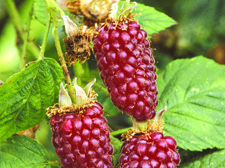|
|
 |
| |
 The more unusual tayberry The more unusual tayberry
|
Time to take your pick of soft fruit before it’s too late
Tom Moggach warns that supplies are running out fast due to the growth of grow-your-own and offers tips on the best ways to extend your harvest
Get your orders in quick for soft fruit this year – demand is sky high, and nurseries are running out of stock.
Normally, you wouldn’t need to hurry. This month would just mark the gentle start of the season for buying and planting “soft” fruits – the wintry period when raspberries, currants, gooseberries and other fruit plants lie dormant, and nurseries send them out in the post.
But suppliers are selling out fast, the result of this “grow-your-own” revival. So get your skates on. And regard soft fruits as an investment – some crop for a decade or more.
If you’re growing established plants, replace tired specimens. If starting from scratch, compose a shortlist of your favourites. Then highlight the fruit that is expensive or hard to find in the shops.
Before ordering, check that the plants will thrive in your growing space. Ideally, order a range of varieties – an early, mid and late-season blackcurrant, for example, will extend your harvest.
Frankly, soft fruits aren’t great for pots and containers – strawberries are your best bet. You get better results growing direct in the soil.
But if you fancy giving it a go, include some loam-based compost such as John Innes No 3, water regularly and feed every fortnight in the growing season – high-potassium feeds promote flowering and fruiting. Gooseberries, I confess, are my big crush. They ripen early in the season, are magic in the kitchen, freeze well and are not widely sold. We inherited a sweet dessert variety on our allotment. The ripe fruit, warmed by the sun, are sensational.
In smaller growing spaces, stick to the “bush” fruit such as currants, blueberries and gooseberries. Choose your sunniest spot, out of the wind. Blackcurrants relish full sun. Red, pink and white varieties (try White Versailles) tolerate shadier spots.
As for blueberries, they are a fussy fruit. Use special ericaceous (acid) compost and water with rainwater. The Northsky or Northcountry varieties are best for containers.
In gardens and allotments, try “cane” fruit such as raspberries. They need sunshine for at least half the day. Autumn fruiting varieties such as Autumn Bliss are easiest to grow and get least hassle from birds.
Don’t bother with blackberries, another cane fruit. They can be rampant, and there are often wild blackberries growing nearby.
For something more unusual, investigate climbers such as the kiwi – good for pergolas, the goji berry and hybrids such as the tayberry – a cross between a blackberry and raspberry.
To buy your plants, here’s the top suppliers: Blackmoor (www.blackmoor.co.uk) list useful growing tips; Thompson and Morgan (www.thompson-morgan.com) identify top varieties for containers; Keepers (www.keepers-nursery.co.uk) and Welsh Fruit Stocks (www.welshfruitstocks.co.uk) offer excellent value. Get in there quick, before it’s too late!
• |
 |
|
|
 |

|
|
 |
|









